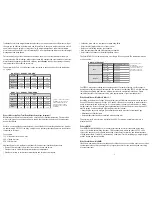
Traditionally, total body weight determined whether or not a person was obese. However, weight
changes can be affected by both muscle and fat gain/loss. A change in weight alone does not tell
you whether it was a gain/loss of muscle or fat. In weight management, you want to maintain
muscle mass while body fat is lost. Monitoring BF% is an important step toward successful weight
management and body health.
This instrument is a personal monitor and should be used in a consistent manner for the most
accurate reading. While readings might vary between this analyzer and other methods of measure-
ment (hydro-densitometry or hand held calipers), your
changes
in body fat percentage shown by
this instrument will be reflected accurately.
The optimal Body Fat % of an individual varies according to age and gender. Use the table below
as a guide:
Why is Measuring Your Total Body Water Percentage Important?
Monitoring your level of body water can be a useful tool for health maintenance. The more lean
muscle you gain as you exercise and get in shape, the lower your body fat and the higher your
body water will be.
Water is an essential body component and is one of the body’s overall health indicators. It makes
up approximately 50-70% of the body’s weight and is present proportionally more in lean tissue as
compared to fat tissue.
For example:
73% of lean muscle tissue is water
80% of blood is water
25% of fat is water
Additionally, water is a medium for biochemical reactions that regulate body functions
• Removes waste products from cells for excretion in urine and sweat
• Provides form to cells which helps maintain body temperature
• Provides moisture to skin, mucous membranes and cushions vital organs
• Lubricates joints and is a component of many body fluids
• Helps flush fat (triglycerides) out of your system
• Helps you feel full and reduces your appetite
• Aids in proper digestion and helps prevent constipation
• Helps reduce the chances of developing kidney stones
The normal TBW% of an individual varies according to BF% and gender. The table below may be
used as a guide:
Your TBW% may vary according to your hydration level. For better accuracy, avoid changes in
hydration level before taking a measurement. The accuracy in estimating TBW% will also decrease
for individuals suffering from illnesses where water tends to accumulate in the body. Please
remember that the scale represents only a good approximation of your total body water.
Why Should I Know My Muscle Mass %?
According to the American College of Sports Medicine (ASCM), lean muscle mass may decrease
by nearly 50 percent between the ages of 20 and 90. If you don't do anything to replace that loss,
you're losing muscle and increasing fat. It is also important to know your muscle mass % during
weight reduction. At rest, the body burns approximately 50 additional calories for each pound of
muscle gained. Some advantages of gaining muscle mass include:
• Reversing the decline in strength, bone density and muscle mass that accompanies age
• Maintenance of flexible joints
• Guide weight reduction when combined with a healthy diet
The normal muscle mass for men is greater than 40%. For women, normal muscle mass is
greater than 34%.
What is BMR?
Your BMR (Basal Metabolic Rate) is the energy (measured in calories) expended by the body,
at rest, to maintain normal body functions. This continual work makes up about 60-70% of the
calories the body uses, and includes the beating of your heart, respiration, and the maintenance
of body temperature. Your BMR is influenced by a number of factors, including age, weight, height,
gender, dieting and exercise habits.
Why Should I Know My BMR?
If you know how many calories your body needs to function, you can calculate exercise and calorie
consumption into your diet and weight loss program to ensure that you are eating and exercising
at your proper level.
BODY FAT % RANGES FOR MEN
Rating
Age
20-29
<13
14-20
21-23
>23
30-39
<14
15-21
22-24
>24
40-49
<16
17-23
24-26
>26
50-59
<17
18-24
25-27
>27
60+
<18
19-25
26-28
>28
Low
Optimal
Moderate
High
BODY FAT % RANGES FOR WOMEN
Rating
Age
20-29
<19
20-28
29-31
>31
30-39
<20
21-29
30-32
>32
40-49
<21
22-30
31-33
>33
50-59
<22
23-31
32-33
>34
60+
<23
24-32
33-35
>35
Low
Optimal
Moderate
High
† Source: University of Illinois
Department of Food Science
and Human Nutrition. Body
Fat Percentage Calculator.
www.ag.uiuc.edu/~food-lab
/ai/bfc.html
†
†
BODY WATER CHART
BF % Range
Optimal TBW % Range
Men
Women
4 to 14%
15 to 21%
22 to 24%
25 and over
4 to 20%
21 to 29%
30 to 32%
33 and over
70 to 63%
63 to 57%
57 to 55%
55 to 37%
70 to 58%
58 to 52%
52 to 49%
49 to 37%
†† Source: Derived
from Wang &
Deurenberg: “Hydration
of fat-free body mass”.
American Journal Clin
Nutr 1999; 69 833-841.
††
2
3




























